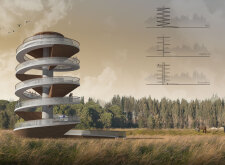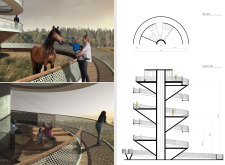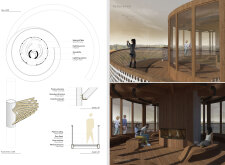5 key facts about this project
The Kurgi Observation Tower is located within the Vidzeme biosphere and serves as a space for visitors to connect with nature. It is designed to provide an engaging experience through a carefully crafted path that spirals upward. This concept draws inspiration from horse promenades, encouraging a natural flow as visitors move through the structure and observe the surrounding landscape.
Design Concept
The design focuses on creating a path that allows for exploration and appreciation of the scenery. The helicoidal path is more than just a way to get from one point to another; it invites people to immerse themselves in their surroundings. As individuals ascend, they encounter different viewpoints that enrich their connection to the environment.
Structural Elements
The primary structure is made of prefabricated concrete, which is both strong and efficient for construction. Timber beams serve as the secondary structure, offering a contrast to the concrete and adding warmth to the overall feel. Steel joints connect various elements, contributing to the stability and durability of the tower.
Material Choices
Observatory platforms are outlined with metal sheet railings that ensure safety while allowing clear views of the landscape. The flooring consists of wood planks, which enhance the tactile experience as visitors walk through the tower. Steel beams support the platform structure, allowing for open gathering spaces that invite visitors to pause and enjoy their surroundings.
User Experience
Accessibility is an essential aspect of the design, achieved through the inclusion of a lift to assist those with mobility challenges. The lighting is provided by LED tubes, offering sufficient brightness while respecting the natural atmosphere. A fireplace serves as a gathering point, creating a cozy environment for visitors to relax and enjoy the landscape.
The combination of structural integrity and thoughtful design fosters a space where visitors can engage with nature. The careful arrangement of paths and viewpoints ensures a satisfying experience as individuals navigate through the tower.





















































